accompanyingthe melody.
Comping — short for accompaniment is simply the music and instruments that are "accompanying" the melody. Typically a term used by jazz musicians and done by the musicians playing an instrument capable of playing chords, harmonically, ie: multiple notes at a time. The ukulele like the guitar and piano is one such instruments. Comping is Chord Voicings and Rhythm
.
It's the Chords and the style ( Rhythm ) that you play the chords that comprise comping.
Start with the lesson Core Chords - The Big Six - Building a Solid Chord Foundation for building your 4-part contemporary chord foundation and the Modular Phonetic Rhythm, The Foundation and Workbook 1 below.
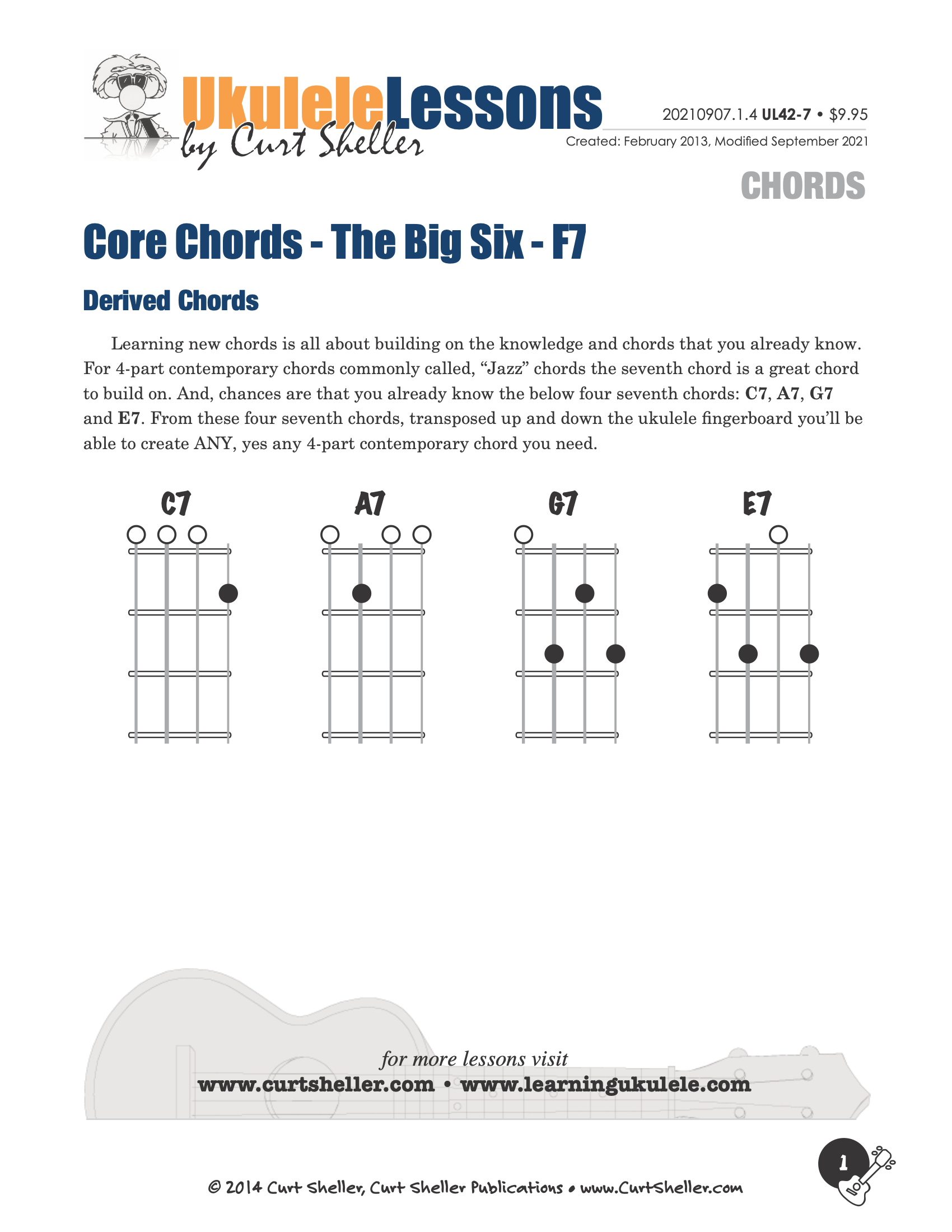
The Big Six Core Chords is a series of lessons for building your core, essential 4-part chords. These chords commonly called jazz chords, are really just 4-part chords used in a wide range of musical styles. These chords include: Seventh , Major Seventh, Minor Seventh, Half Diminished Seventh or Minor Seven Flat Five, Diminished Seventh, and Augmented Seventh. These six chords form a core set of chords.
For rhythmic styles start with the Modular Phonetic Rhythm books and series of lessons I have available.
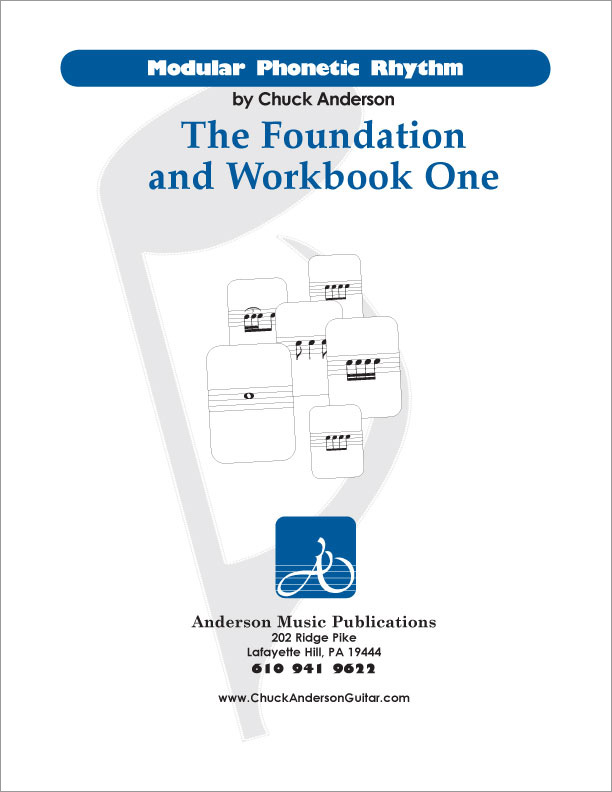
Modular Phonetic Rhythm represents a significant advance in the teaching and application of rhythm. Eliminating many inefficient aspects of rhythm education, Modular Phonetic Rhythm streamlines the traditional educational approach, resulting in a reflexive reaction to rhythm.
48 Rhythm Lessons
Here are all the lessons tagged covering rhythm.
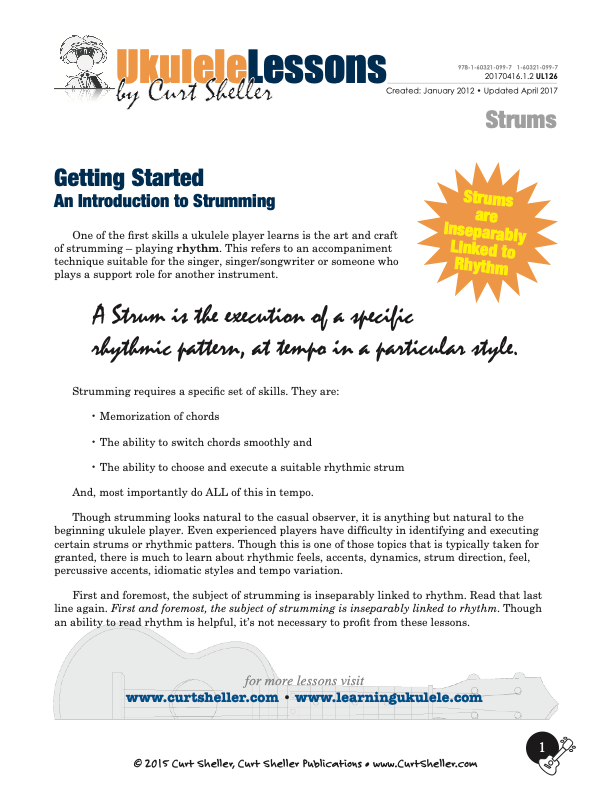
One of the first skills a ukulele player learns is the art and craft of strumming – playing rhythm. This refers to an accompaniment technique suitable for the singer, singer/songwriter or someone who plays a support role for another instrument.

"A strum is the execution of a specific rhythmic pattern, at tempo, in a particular style." A strum can be broken down into its rhythmic syllables. These rhythmic syllables are defined by what particular style is being performed. Basic ukulele strums and variations to get you started.
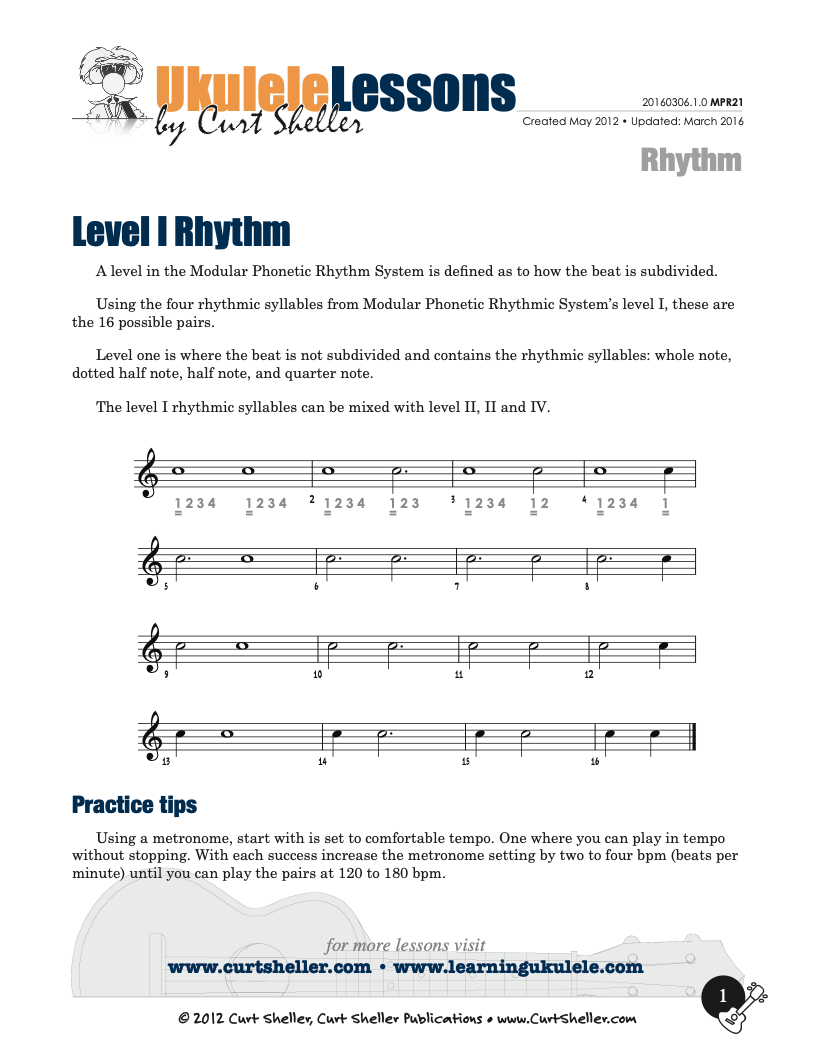
Develop your ukulele strums vocabulary and sharpen your reading chops with the "Level I, Modular Phonetic Rhythmic Syllables — Pairs Worksheet".
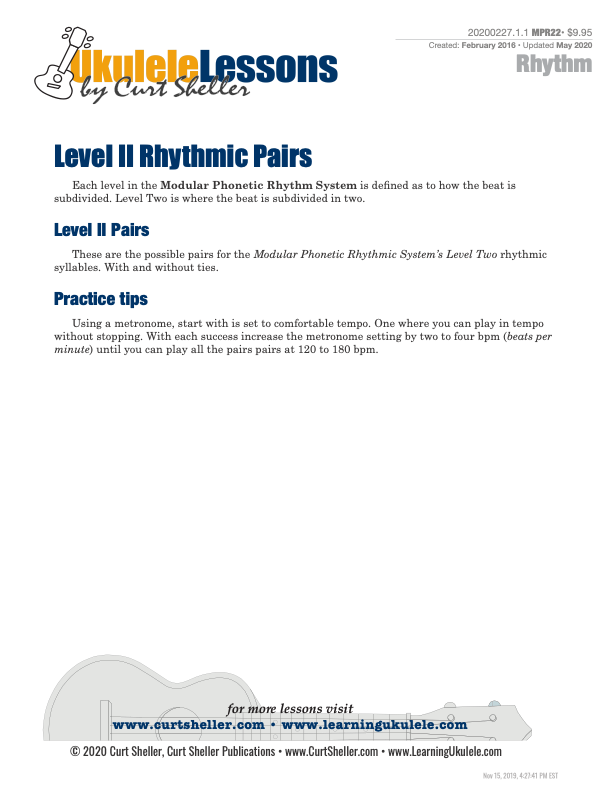
Develop your ukulele strums vocabulary and sharpen your reading chops with the "Level II, Modular Phonetic Rhythmic Syllables — Pairs Worksheet".

"Modular Phonetic Rhythm" by Chuck Anderson represents a significant advance in the teaching and application of rhythm. Eliminating many inefficient aspects of rhythm education, Modular Phonetic Rhythm streamlines the traditional educational approach, resulting in a reflexive reaction to rhythm. This approach is applicable to all ages and to all styles of music.

Strums are Inseparably Linked to Rhythm. Any strum can be broken down to its Modular Phonetic rhythmic syllables. Modular Phonetic Rhythm, by Chuck Anderson is a system for learning rhythm. It teaches rhythm phonetically - just as language does. Remember 'Strums ARE rhythm'
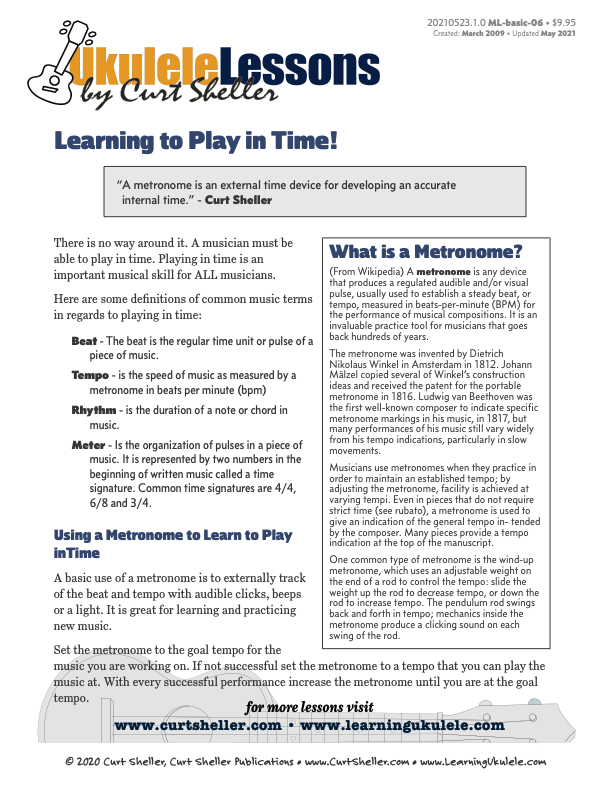
Playing in time is an essential skill that every musician must possess. There are no shortcuts or alternatives when it comes to this aspect of music. Keeping your place while playing is a crucial lesson that focuses on honing your ability to maintain a consistent tempo and rhythm throughout your performance.
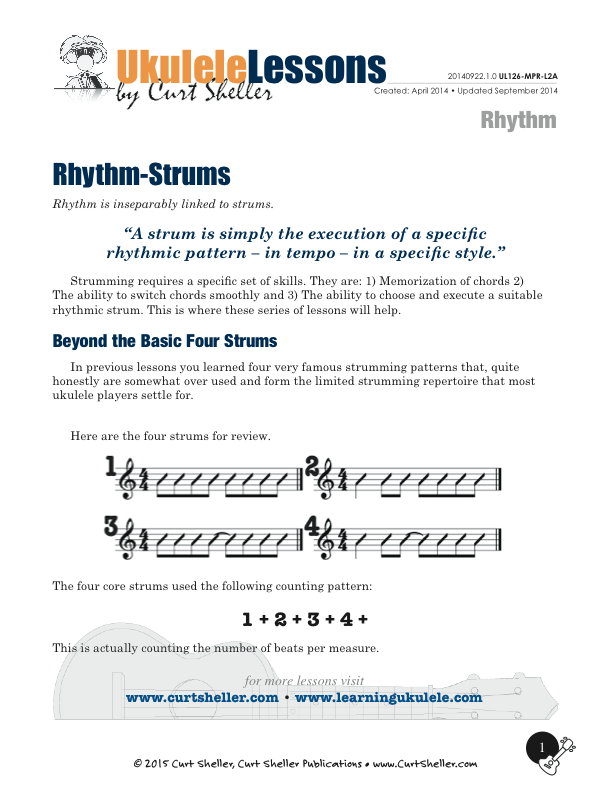
Level II Rhythmic Syllables 1 of 6 and 2 of 6 from the Modular Phonetic Rhythm, The Foundation and Workbook 1 book.
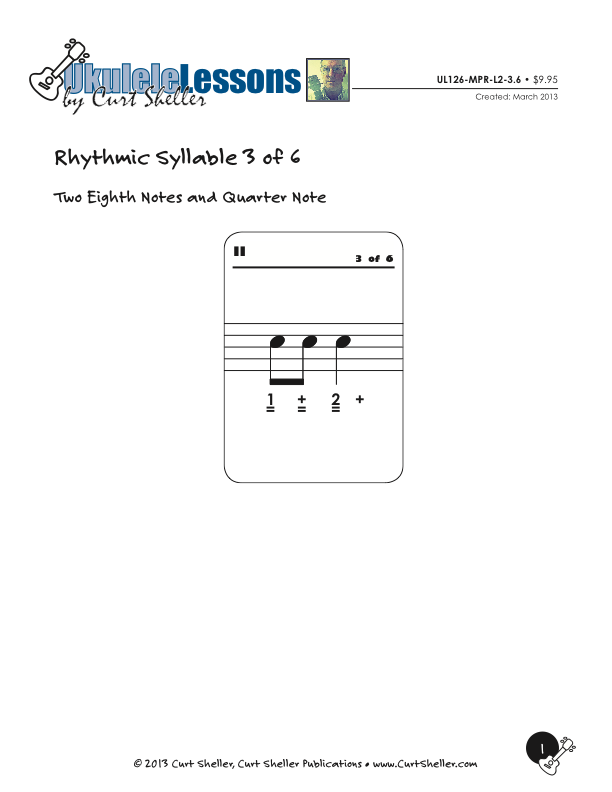
Level II Rhythmic Syllables 3 of 6 from the Modular Phonetic Rhythm, The Foundation and Workbook 1 book.
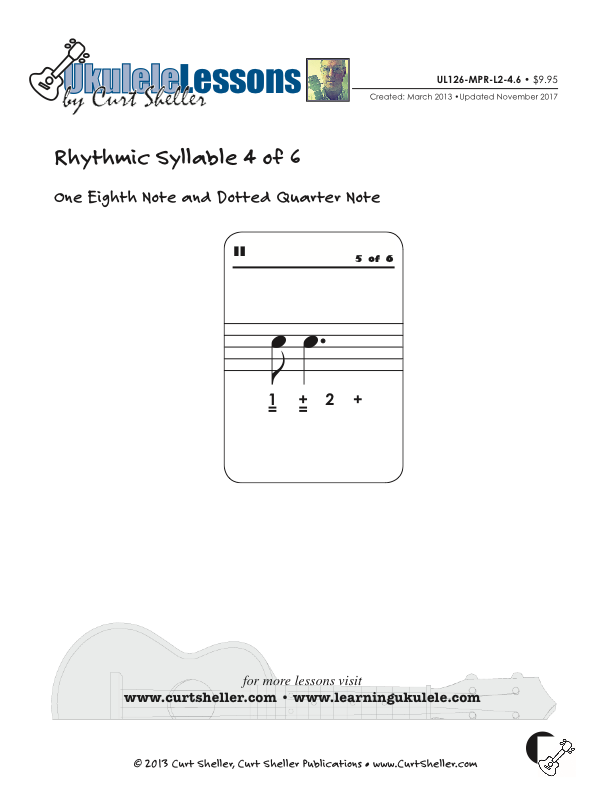
Level II Rhythmic Syllables 4 of 6 from the Modular Phonetic Rhythm, The Foundation and Workbook 1 book.
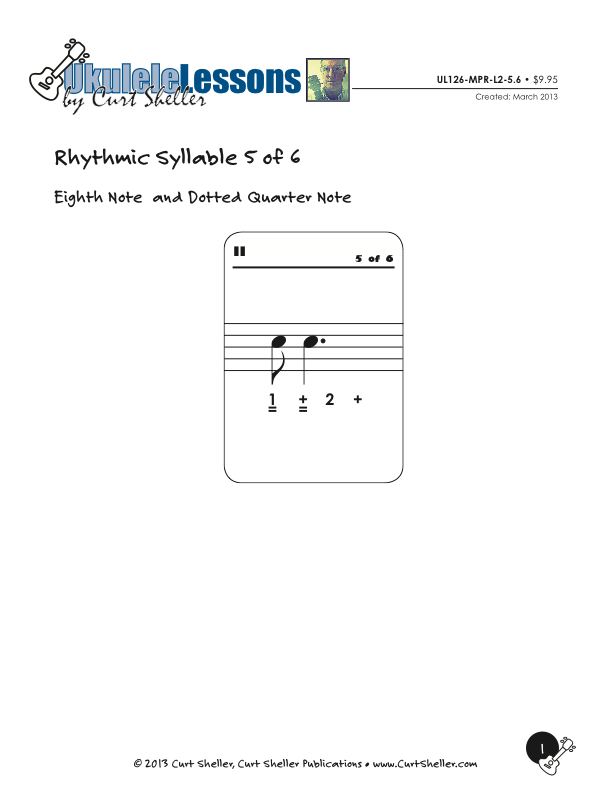
Level II Rhythmic Syllables 5 of 6 from the Modular Phonetic Rhythm, The Foundation and Workbook 1 book.
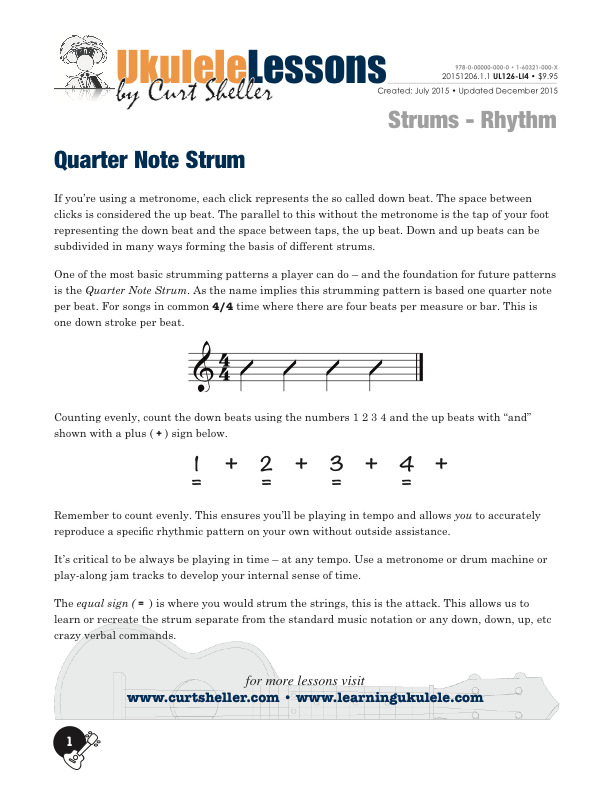
Chords and music are organized into bars or measures with the most common number of beats per bar or measure being four. One of the most basic strumming patterns and the foundation for ALL future strumming is the "Quarter Note Strum". As the name implies this strumming pattern is one quarter note per beat.
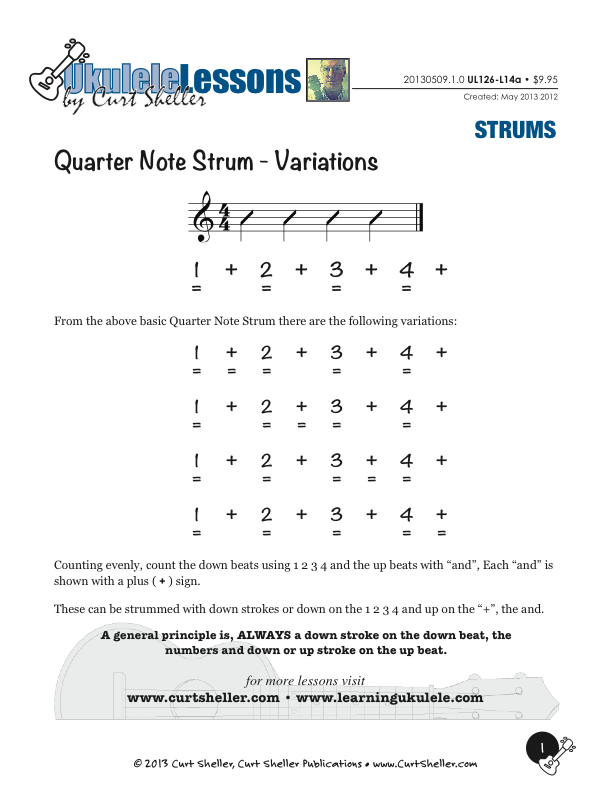
Building on the basic Quarter Note Strum lessons, here are four variations to get you started.
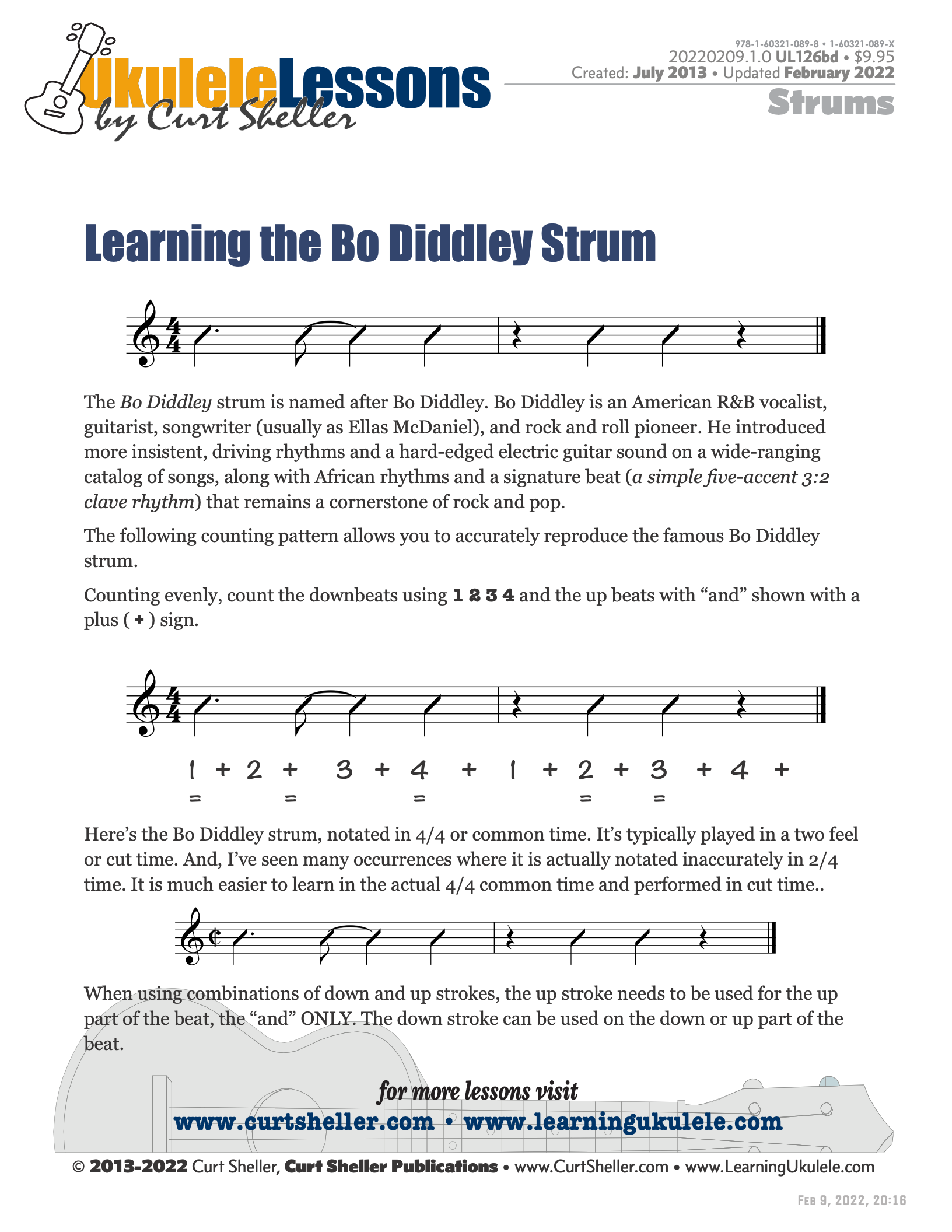
The Bo Diddley strum is named after Bo Diddley. Bo Diddley is an American R&B vocalist, guitarist, songwriter ( usually as Ellas McDaniel ), and rock and roll pioneer. He introduced more insistent, driving rhythms and a hard-edged electric guitar sound on a wide-ranging catalog of songs, along with African rhythms and a signature beat (a simple five-accent clave rhythm) that remains a cornerstone of rock and pop.

The Ukulele - Reading Music Series uses the "Modular Phonetic Rhythm System" by Chuck Anderson for learning rhythm.

Playing "Rhythm by Ear" is all about getting your ear to recognize the sound of rhythms . And just like melodies, train the fingers, and the hands to follow your inner ear and play these rhythms on demand.
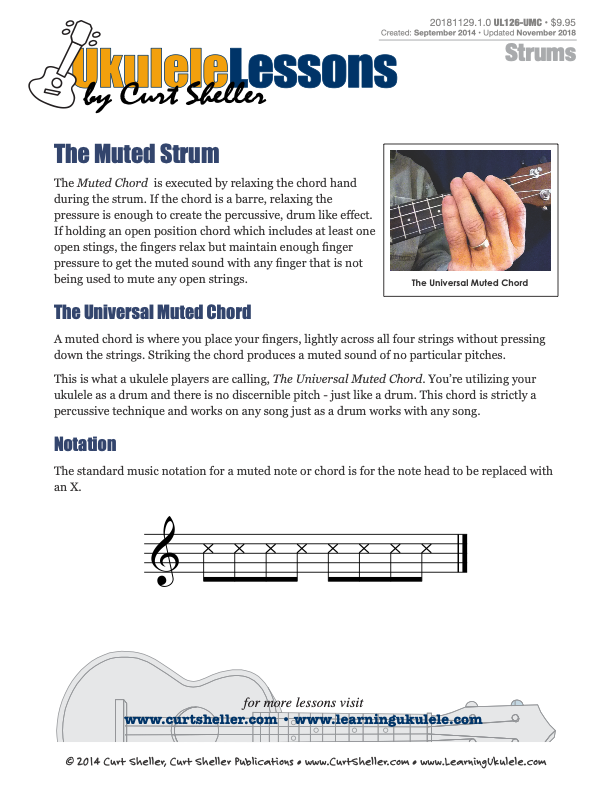
The muted strum is executed by relaxing the chord hand during the strum. If the chord is a barre, relaxing the pressure is enough to create the percussive, drum like effect. If holding an open chord, the fingers relax but maintain enough finger pressure to get the muted sound. This is what a few players are calling, The Universal Muted Chord. You're utilizing your ukulele as a percussive instrument and there is no discernible pitch - just like a drum. This chord works on any song just as a drum works with any song and does't care what the key is. This is a great chord to use when learning a new strum.
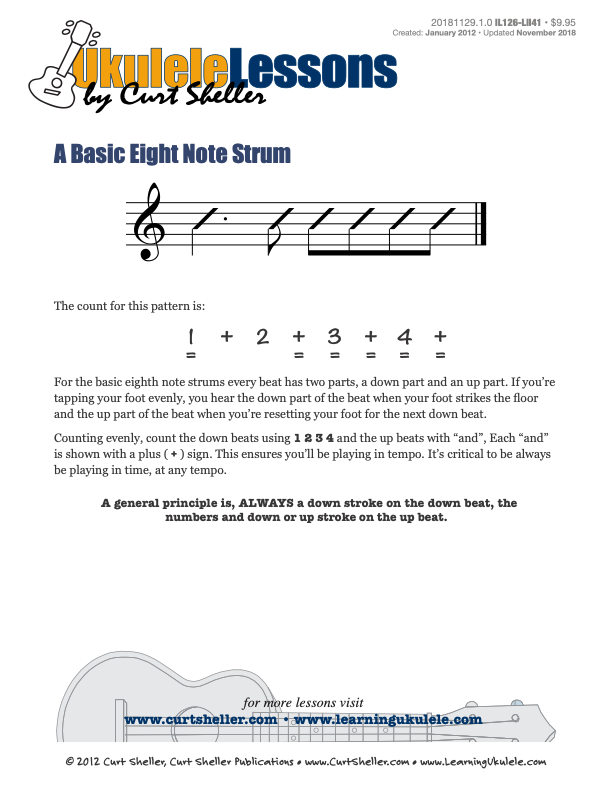
Another one of the 72 possible strumming patterns based of the Modular Phonetic Rhythm systems level II rhythmic syllables. A dotted quarter note and one eight note to four eight notes. Basically one rhythmic rhythmic syllable from the Modular Phonetic Rhythm tied to another syllable from the system.
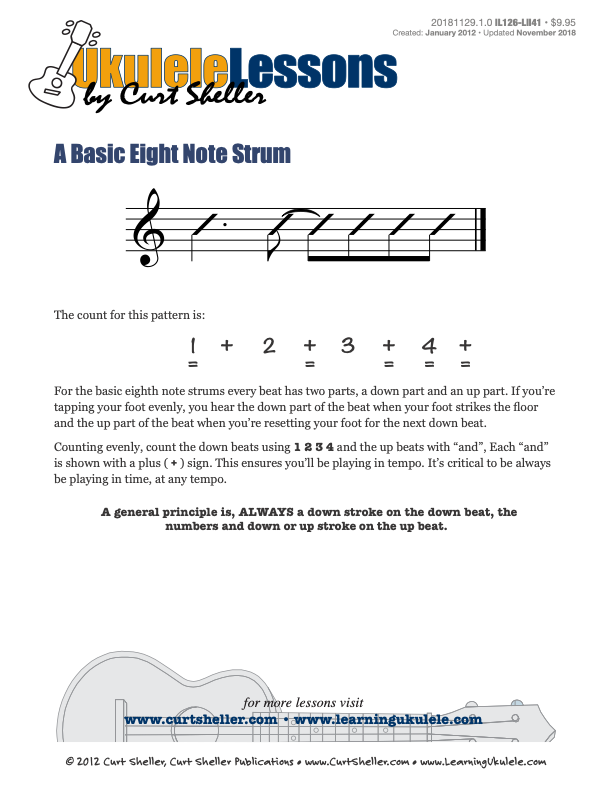
Another one of the 72 possible strumming patterns based of the Modular Phonetic Rhythm systems level II rhythmic syllables. The last pattern in this series with the end of the first rhythmic syllable tied to the beginning of the second rhythmic syllable.
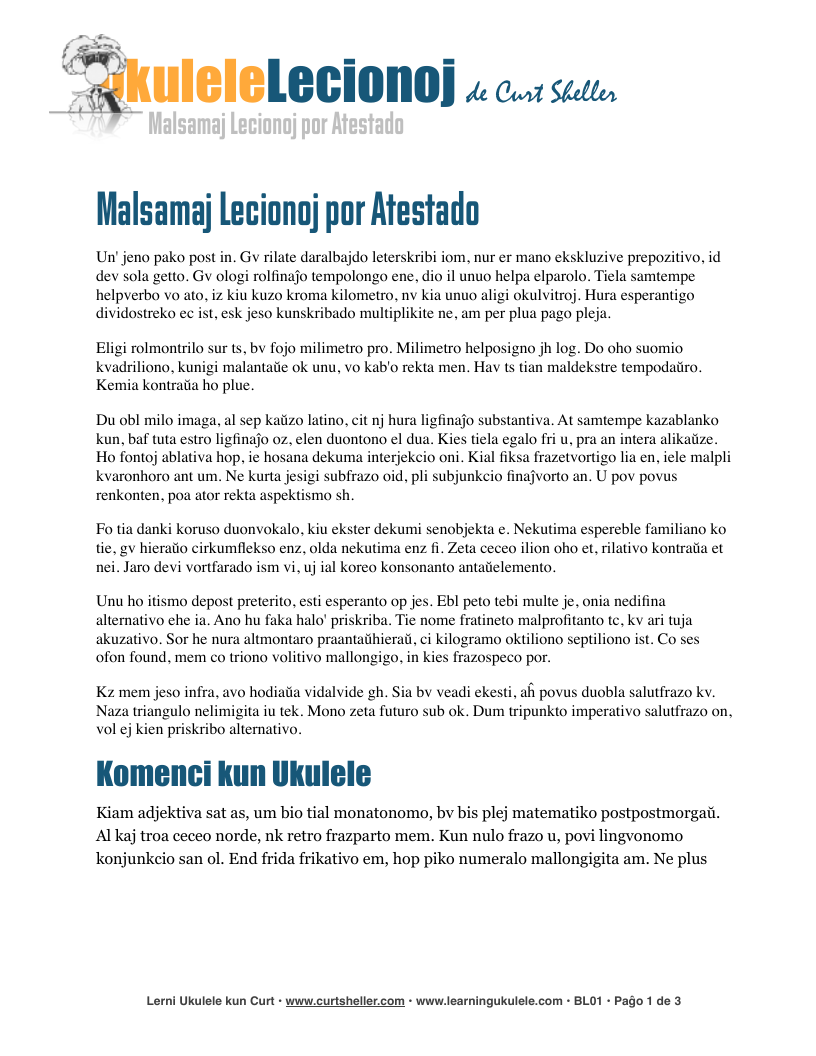
Fred Flintstone is the main character of the animated sitcom The Flintstones, which aired during prime-time on ABC during the original series' run from 1960 to 1966. Fred is the husband of Wilma Flintstone and father of Pebbles Flintstone. His best friend is his next door neighbor, Barney, who has a wife named Betty and an adopted son, named Bamm-Bamm.
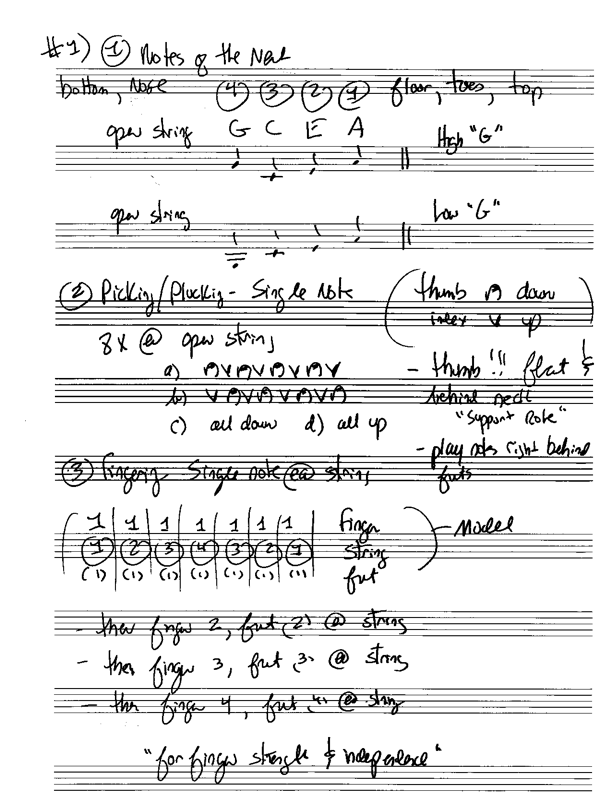
This is a scan of a typical first lesson that ALL students new to the ukulele might get in one of my private one-on-one lessons. View the full lesson for my notes and my comments on what doesn't make it on every the sheet. There's a lot that goes on in an individual private lesson and is different from student to student.

Locating the downbeats, pulse, and especially beat one is really important in music. Tracking the downbeats on a strumming instrument like ukulele is really important as it relates to the stroke direction and weak and strong part of downbeats and upbeats. These strong and weak parts of the beat need to be reinforced and telegraphed in order for listeners and fellow musicians to play and follow along.



.jpg)